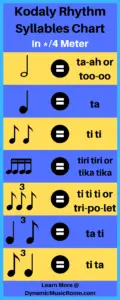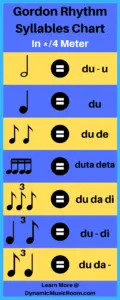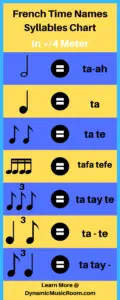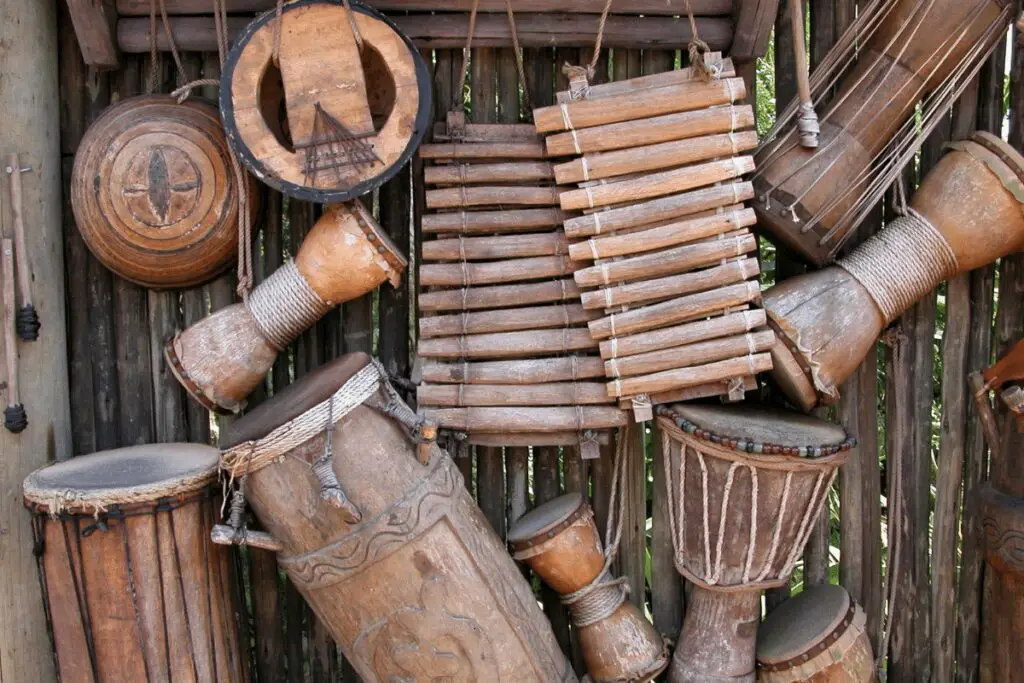Rhythms are an essential part of music. This is why we made the Ultimate Guide to Counting Rhythm and Rhythm Syllables.
There are many methods for counting rhythm using different rhythm syllables. It can all be overwhelming, but we’re here to help.
This guide includes:
- What rhythms are
- What rhythm syllables are
- Types of rhythm
- General types of rhythm counting systems
- 9 rhythm counting systems
- How to pick the right rhythm syllables
- 12 rhythm games and exercises
Read on for more details, and make sure to use the table of contents to help you jump around the guide. This is a big one!
Note: Along the way, you’ll also find links to specific articles on different topics. Check those out for even more details about each section.

Save time with these 60 FREE Music Resources to use in your room right away!
Stop searching the whole internet to find good activities. I’ll help you cut to the chase with my favorite 60 FREE resources.
Table of Contents
What Makes Up A Rhythm?
In this section, we’ll briefly cover the 4 elements that make up rhythm. This is useful information for any level of musician or teacher to know.
At a basic level, rhythms are patterns of longer and shorter sounds. But these sounds are also made of the following elements.
Another way of thinking about it is this: rhythm is how the duration of a sound interacts with these 4 elements.
Beat
The pulse that holds the music together is the beat. Steady or unsteady, the beat still unifies the music.
The beat provides the context for the rhythm to exist over.
Tempo
Tempo is Italian or “time.” With music, tempo refers to the speed of the beat.
Rhythm’s connection to the beat means it’s also connected to tempo.
Tempo is critical in building internal consistency.
Meter
Meter is the pattern of strong and weak beats as well as how many units the beat is divided into. Meter is divided into:
- Simple (strong-weak or 2)
- Compound (strong-weak-weak or 3)
- Duple (divisions of 2)
- Triple (divisions of 3); notes in compound meter
Rhythm and their values are connected to the meter.
Accent
Accent is often used to refer to a note played a little louder than the rest. But it also can be referred to any special emphasis (or de-emphasis) of a note.
In music terms, these are style markings such as:
- Accent
- Staccato
- Legato
- Tenuto
- Marcato
Note: Check out What Makes Up A Rhythm? for more details and discussion examples with students of different levels.
3 Types Of Counting Rhythm

Rhythms can be broken down into 3 different types depending on their relation to the beat. In general, the first two types are easier to teach than the 3rd type.
Rhythm A Beat Or Longer
The first type of rhythm are those that line up with the beat or extend longer than the beat. These rhythms will fill up the beat completely.
These change depending on the specific meter (as all rhythms do). But as an example, here are beat or longer rhythms in 4/4 meter:
- Quarter note
- Half note
- Dotted half note
- Whole note
Rhythms Inside A Beat
The second main type of rhythms is those who fill up the inside of the beat. They can divide it evenly or unevenly, but they don’t stretch over the beat.
Examples in 4/4 meter include, but aren’t limited to:
- Eighth notes
- Sixteenth notes
- Triplet eighth notes
- Dotted eighth-sixteenth
- 1 eighth-2 sixteenth (and vice versa)
Rhythms Longer Than A Beat And Inside The Beat
These rhythms are the kind that stretch over the beat line but then don’t entirely take up another beat. The best example of this is the dotted quarter in 4/4 meter.
These rhythms are actually quite complicated if you stop to think about it. They require an understanding of notes longer than a beat but also smaller than the beat.
Examples in 4/4 include but aren’t limited to:
- Dotted quarter note
- Triplet quarter notes
- Eighth quarter eighth syncopation
What Are Rhythm Syllables?
Rhythm syllables are words or sounds that help musicians perform, read, and improvise rhythms more effectively. These rhythms are a staple of music education programs from elementary to collegiate levels.
Just like solfege syllables, these are a tool for helping perform a musical idea.
2 Types Of Counting Rhythm Systems

Save time with these 60 FREE Music Resources to use in your room right away!
Stop searching the whole internet to find good activities. I’ll help you cut to the chase with my favorite 60 FREE resources.
Rhythm syllables and counting systems can be broken down into two basic types. Read on for a brief description of each type.
Replacement Syllables
Replacement syllables are when a system replaces a specific rhythm value for a syllable. For example, every time you saw a quarter note, you may say “ta”.
If the meter changes, you still say “ta” for the quarter note even though it may now be the division as with 2/2 time.
Some replacement systems can be used as a beat function system as well. Modern trends in rhythm syllables are moving towards beat function (discussed below).
Here are examples of common replacement syllable systems:
- Kodaly syllables (ta ti ti)
- French time names
- Mnemonic (Fruit Syllables)
The main pros for this system are how quickly students learn to use it and how many other teachers use these systems.
The main con is that the system is limited in other meters. It doesn’t reinforce relation to beat as the meter changes.
Beat Function
A beat function (or functional beat) system is where the syllables match the placement within and around the beat depending on the meter.
For example, any note landing on the beat would be called “du”. If the meter were to change to 2/2, now the half note landing on the beat becomes “du.”
This applies even to eighth notes on the beat. Two paired eighth notes in 4/4 with the first one landing on the beat would be called “du.”
In these systems, technically no rhythm is given a name, but the places where they land are given names.
Another example in takadimi:
- Notes on the beat = ta
- Notes halfway between beats = di
- Notes one quarter of the way in = ka
- Notes three quarters of the way in = mi
So, 4 sixteenth notes would be called “takadimi.”
Some rhythm systems are used as both replacement syllables and beat function. Here are ones typically considered beat function:
- Numbers: 1 E And A
- Gordon/Froseth
- French Time Names*
*This use of French Names is more modern.
The main pros for this type are their ability to be used as the meter changes and it helps musicians understand the relationship between beat and rhythm better.
The main con is that they are more complicated to apply true understanding in younger ages (unless you just start without explanations and then explain later).
9 Different Rhythm Syllables And Counting Rhythm Methods

In this section, you’ll see the 9 main methods for counting rhythms. This is a short overview of each system; for more details, check out the dedicated articles.
Numbers: 1 E And A
1 E And A counting is dependent on the meter. This makes this a beat function system.
This counting system is a favorite of middle, high, and collegiate instrumental programs.
In 4/4, the quarter note gets the beat and there are 4 beats in the measure. These are counted by the number beat it is in the measure.
For example, 4 quarter notes would be counted: 1, 2, 3, 4
The division of the beat (in the cases of 4/4: eighth notes) are counted with “and”s. 8 eighth notes would be counted: 1 and 2 and 3 and 4 and
The subdivision (sixteenth notes in 4/4) are counted with “e” and “a” in between the divisions. 16 sixteenth notes would be counted: 1 e and a 2 e and a 3 e and a 4 e and a.
Triplet divisions can be counted as “1 la le 2 la e” or “1 trip-let 2 trip-let”. There are some who also use “1 ti ta 2 ti ta.”
Note: Head on over to our 1 E And A post for more info and examples.

Orff And Rhythm
There is no one rhythm method for Orff rhythm syllables. That being said, there is support in Orff texts for using mnemonic syllables (see below).
However, many Orff teachers use one of the other popular systems. Kodaly counting, French Time Names, and TaKeTiNa are three popular choices.
Note: For more details, check out Orff rhythm syllables.
Kodaly Rhythm
The Kodaly rhythm syllables, also known as ta ti ti or ta tee tee, are one of the more popular choices along with the numbers, takadimi, and Gordon systems. Kodaly traditionally uses replacement syllables.
For a full chart and breakdown, visit the linked article. Here is a brief example of the syllables:
- Quarter note – ta
- Paired eighth notes – ti ti
- All rests – (no sound)
- Half notes – ta-ah or too
- Whole note – ta-a-a-ah or too-oo
- Sixteenth notes – tiri tiri or tika tika
- Eighth-quarter-eighth – syn-co-pa
- Dotted quarter-eighth – tam-ti
- Dotted eighth-sixteenth – tim-ka
This system is a favorite in elementary programs.
Note: Have a look at the Kodaly Counting System or Ta ti ti for more information.

Dalcroze And Rhythm
As with Orff, the Dalcroze approach doesn’t teach a specific rhythm system universally. However, it is common for the teachers to use mnemonic syllables and the French Time Names.
Note: You may find this Dalcroze rhythm syllables post helpful as well.
Takadimi
Takadimi is an example of the beat function system. This system is inspired by classical Indian music.
The syllables change depending on meter, but here is an example as if in 4/4:
- Quarter note = ta
- 2 eighth = ta di
- 4 sixteenth = taka dimi
- 3 eighth in triple = ta ki da
- 6 sixteenth in triple = tava kidi dama
- Half note = ta-ah
Takadimi is most popular at the collegiate level, but it’s being seen more and more at the high school level as well.
Note: Check out these takadimi games.

Gordon/Froseth Rhythms
The Gordon syllables were inspired by James Froseth. From here on, they’ll be called Gordon syllables.
Gordon rhythm syllables are another beat function system. These syllables are based around the sound “du” rather than most system’s “ta.”
This syllable is meant to be easier to help teach proper articulation on wind instruments. Most of the time you’ll see this in elementary music programs, but there are some bands using it.
Examples in 4/4:
- Quarter note = du
- 2 eighth = du de
- 4 sixteenth = duta deta
- 3 eight in triple = du da di
Note: This Gordon rhythm syllables post may have more details if you want more.

Conversational Solfege Rhythms
Dr. John Feierabend’s Conversational Solfege traditionally uses the Gordon rhythm syllables.
Note: Learn more about what Conversational Solfege is.
French Time Names
The French time names started in France in the 19th century with the French words for the rhythms being used as syllables. In the later 19th century, Lowell Mason adapted them for use in elementary schools in America.
Here are examples of the French time-names system in 4/4:
- Quarter note = ta
- 2 eighth = ta te
- 4 sixteenth = tafa tefe
- 3 eighth in triple = ta tay te*
*”Te” in this case is pronounced “tee”.

Mnemonic/ Fruit Rhythm Syllables
Mnemonic or fruit rhythm syllables are common with Orff and Dalcroze teachers but are used to some degree by many. The system replaces rhythm sounds with words matching the feeling and cadence of the syllables (Pear = quarter note).
The reason you may have heard this called “fruit rhythm syllables” is because it’s common to use fruit as one of the themes.
Here’s an example of rhythms as fruit (in 4/4):
- Quarter note = pear
- 2 eighth = apple
- 4 sixteenth = watermelon
- 3 eighth in triple = strawberry
Note: This system can be used as a beat function or replacement system. It’s up to how the teacher uses it.

How To Pick The Right Way To Count Rhythm
Take the quiz or read below!
Sorting through all these methods isn’t easy. But what it ultimately comes down to is what you feel more comfortable with.
As long as you intentionally tech rhythms and you’re consistent, it will all work out just fine. It’s simply a matter of preference.
For example, I personally mostly use the traditional Kodaly system because this is what many of the others use. But I have no qualms with the other ones.
The key is consistency. Switching all the time will confuse your kids more.
But, if you’re stuck, here are some quick steps that may help you.
1. How old are your students?
If your students are older, you may want to use Numbers or Takadimi. If your students are younger you may want to use Kodaly, Gordon, or French Time Names.
2. Do you identify with a method?
If you identify with a method, don’t waste your time fretting over which to use. Just pick the one your method seems to prefer (read above).
3. Do you want beat function or replacement system?
As you read the section above, one of the two types may have spoken to you. You may have thought: This type makes way more sense.
If that’s the case, pick one from the list inside that type above.
4. What is easiest for you, personally?
Sometimes it just comes down to what feels best to you. You’re the one that’s going to have to teach it to all of your classes.
If you’re using it over and over again, you better like it too.
Grab some simple rhythms and try saying them with each of the different systems. By the end, one may speak to you, and this is the one you should choose.
Rhythm Mastery Process
In this section, we’ll look at the sound before symbol process of developing musical skills. These are just general steps existing outside of most methods, but all methods follow these general rules.
The name for this is called “Sound Before Symbol.”
#1 Say The Rhythms
The first step is just to practice using the system to say some rhythms. Start simple and have students echo you.
Don’t show them anything yet, let them develop a fluency with just saying and copying the rhythms. This is like when babies babble sounds like you do.
#2 Move The Rhythms
Use the body to help move the rhythms. For example, clap the rhythms as you echo them.
You could also have students create new motions for each value. Stomp for quarter notes (or the beat) and pat the head for eighth notes (or division).
This develops deeper understanding and also differentiates between different types of learners.
#3 Read The Rhythms
Either with pictures or actual notation, you can now read the rhythms with your chosen system. It’s time to start throwing in some good rhythm games for fun too (as in the next section).
#4 Create Rhythms
The next step is to have students practice creating new rhythms. Either by using manipulatives or actual writing the notes, students can compose using this understanding.
#5 Improvise Rhythms
The highest level of understanding is improvisation. With improvisation, they plan and visualize what they’re performing on the spot.
12 Fun Rhythm Games

Rhythms themselves are just fun to do, but if you’re looking for a way to engage students a little more, check out these 12 fun rhythm games. All of these games can be played with any rhythm syllable system.
Note: Many (but not all) of these games are also discussed in other rhythm articles.
Rhythm Train
My kids love this game. It allows you some easy ways to assess how they’re understanding rhythms.
To start, students think of an 8 or 4 beat rhythm pattern using what they know.
As the game starts, students take turns saying their rhythms to the steady beat. It should sound like one long stream of steady rhythms.
To help, you may want to play a drum while they say their rhythms,.
I challenge my kids to get through their whole class with three or fewer mistakes or “wobbles.” Three of these and the train crashes.
You can play it with the teacher as the train and the students the track. Or you can have students marching like a train while they do it.
You can get wobbles by:
- Saying the rhythm to an unsteady beat
- Forgetting your rhythm
- Performing a rhythm incorrectly
- Making a rhythm not in the correct amount of beats
I’m usually pretty easy the first couple times we play, but then I get pickier.
King Of The Mountain
Though I first saw this as a math review game, I’ve since seen other music teachers doing it, and I’ve added this to my game cycle as well.
The only thing you’ll need are flashcards with the correct rhythms.
Two students approach you as you hold up a card. The first one to say it correctly wins.
The winner is the new King/Queen of the mountain, and the next student comes up to challenge.
You repeat until all students have gone, and the last winner is the official King/Queen of the mountain.
This can also be done as a center if you’ve already taught and played this game with the students as a whole.
Rhythm Relay
Rhythm relay is pretty much what it sounds like. But this doesn’t mean it’s not a fun way to move and compete with rhythms.
Split the class into teams of at least 4. When you say go, they race* to you as you hold up a rhythm.
If they say it correctly, they go back and tag the next in line and sit down. This repeats until all teams have sat down.
The first team that sat down wins**!
*I don’t have my kids run. I make them hop or shuffle usually.
**I also pick a team to win the “most positive” award. This is the team that cheers on their teammates and other classmates the best.
Rhythm Soup
To play this game, you need bean bags (I like these Prextex ones) and a bucket or drum to toss them into.
The goal is to create a rhythm soup by putting in different rhythm ingredients. Students say a rhythm and then throw the bean bag in.
Try these requirements for a challenge:
- Must start with a specific note
- Must end with a specific note
- Use so-and-so types of rhythms
- Can’t repeat ones that have already been said
- Must start with the one the last rhythm ended with
- As with many of these, once this game has been taught, you can use it as a center and to give you some formative assessment.
Who’s My Partner?
This activity can get a little crazy, but it’s a blast to do with relatively little setup.
All you need are rhythms on individual cards. But you need 2 of each rhythm.
Hand out the cards so that all students will have a matching card with another student somewhere in the room.
Without letting anyone else see, they have to find their partner by repeatedly saying the rhythm until they find their match. Once they do, they sit quietly.
Note: This is also a great way to find random partners for some kind of cooperative activity later on that lesson.
Rhythm Jeopardy
You play this just like regular Jeopardy, but now it’s all focused on rhythms.
Personally, I just write it on my white board. But this free Jeopardy builder is quite easy to use.
Here are the categories I like to use:
- Read the rhythm
- Decode the rhythm
- Name that rhythm
- Mystery song
- Improvise rhythm
Sing-Say-Think
Pull a 16 beat rhythm (or longer) from a folk song the kids know well. Start by making them say the rhythm with rhythm syllables.
Then, it’s time for a challenge.
As students say the rhythm, you strike a triangle or other instrument. This means they have to switch to the next step in the cycle.
The cycle switches between singing the original song, saying the rhythm syllables, and thinking the song in their head.
You can make this game gradually harder by increasing how often you make them switch. You can also allow students to take over the leader role and hit the triangle.
Note: Students love to be in charge of the triangle, but be careful to teach them not to strike too often or it becomes impossible.
Flashcard Challenge
This is just a twist of any common flashcard reading activity. This can be done with any flashcards you like.
The key is that I treat the flashcards like a game. They have to pass certain levels as they go.
The levels go like this:
- T says: “1, 2, ready, say.” Students read rhythm.
- Students read all rhythms in a row.
- Split class in two and alternate cards.
- Students only read certain rhythms (only say the quarter notes).
- Split class into small groups and each group says only certain rhythms.
Note: Try to really play up the challenge of the rhythms. I do dramatic voices and make it like a game.
I Have, Who has?
This traditional game is a ton of fun, but it takes some setup work. You need special flashcards handed out to the kids to make it work.
The cards have an “I have” rhythm and a “who has?” rhythm. One person starts by reading their card:
Example: “I have du du dude du. Who has dude dude du du?”
Another student will have that rhythm. They read their cards in the same fashion.
Then, you continue until all the cards have been used.
This requires serious planning ahead with cards if you try it on your own. Or you can just buy it from Teacher Pay Teacher (not me!).
This video does a good job of explaining how this game works.
Disappearing Rhythms
You’ll need a longer rhythm pattern for this one (at least 16 beats). Then, you’ll want to go through these steps.
- Students say the rhythm up with syllables.
- Cover up one of the beats of rhythm.
- Students say the rhythm while still saying the covered rhythm.
- Cover up another and repeat.
- Continue until all are covered.
You can also have students think the rhythm internally.
I just cover up the rhythm with sticky notes, or you can put it on a PowerPoint and place squares over them as you go.
Rhythm Rally Robin
This cooperative learning activity is played with the following steps:
- Students move around the room silently until the music stops.
- They partner up with the nearest person to them.
- The whole class takes 5 seconds to think of several rhythm patterns.
- Partner 1 (who you pick) says one rhythm.
- Partner 2 says one rhythm.
- Repeat until the Teacher gives the quiet signal.
- Students thank each other for sharing.
- Music starts and the activity repeats with different partners.
Split Rhythm Game
This game is one I just made up the other day, and my kids seem to love it so far. It’s just another twist on having them read rhythms.
For this, I use RhythmRandomizer (which is amazing!) and a classical piece or march.
You also need hula hoops and a brief explanation to the kids. If you’re working on 3 rhythms (quarter note, eighth notes, and quarter rest), you’ll 3 different colors of hoops spread around the room.
You can have more hoops, just keep them within the same 3 colors. Then, you assign the colors with a rhythm value (red = quarter note, blue = eighth notes, yellow = quarter rest).
Here are the steps:
- Students move/march around the room.
- When the music stops, the stop in a hula hoop.
- They say the rhythm, but only the values that match their color.
- Click on the rhythm for a new one.
- Repeat 4x.
- Change the measures from 1 to 2 on the site.
- Repeat 4x.
- Change the measures from 2 to 4.
- Repeat and make harder as desired.
Rhythm Vocab List
Here is a brief list of vocabulary related to rhythm you may want to look at if you see a term you’re unfamiliar with.
Rhythm – Long and short sounds as they exist in relation to the beat.
Beat – The pulse that unifies the music.
Meter – The pattern of strong and weak beats. Also, how many divisions are in a beat (usually 2 or 3).
Time Signature – The number designating the meter. The top number is the number of beats in a measure, and the bottom number tells what type of note gets the beat.
Example: 4/4 means 4 beats per measure and the quarter note gets the beat.
Macrobeat – Another word for the beat.
Microbeat – Another word for the divisions.
Division – How many sounds the larger beat is divided into. Usually 2 or 3 divisions. In 4/4, the eighth notes make up the 2 divisions.
Subdivision – A splitting of the division. In 4/4, sixteenth notes are the subdivision.
Duple – The word for the meter when the beat is divided into 2 as with 4/4 meter.
Triple – The word for the meter when the beat is divided into 3 as in 6/8 meter.
Conclusion
I hope you enjoyed this ultimate guide to counting rhythms and rhythm syllables. Learning rhythms is fun and important to all musicians regardless of their levels.
Make sure you check out the linked posts for specific details on each of the syllable systems as well as handy reading charts.

